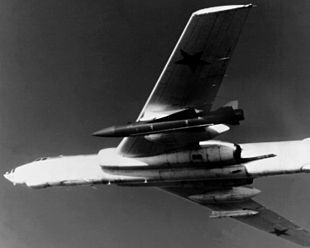KSR-5



The Raduga KSR-5 (NATO reporting name AS-6 Kingfish) was a long-range, air-launched cruise missile and anti ship missile developed by the Soviet Union. It was essentially a scaled down version of the Kh-22 'Kitchen', built to be carried by the less capable Tu-16.
Variants
The Raduga KSR-5 was developed in variants to be deployed as a land attack missile and an anti-ship missile. The missile was designed to be fitted with either a conventional or nuclear warhead.
Operational history
The Raduga KSR-5 was deployed aboard such Soviet aircraft as the Tupolev Tu-16 'Badger' in Tu-16K-26, Tu-16KSR-2-5, and Tu-16KSR-2-5-11 variants, as well as the Tu-22M Backfire. Post 1991 with the retirement of the Badger, the KSR-5 warstock was converted into supersonic targets.
Operators
Specifications
- Length: 10 m (33 ft)
- Wingspan: 2.5 m (8.2 ft)
- Diameter: 0.9 m (3.0 ft)
- Launch weight: 4,000 kg (8,800 lb)
- Speed: Mach 3.5 (2,664.2 mph; 4,287.7 km/h; 1.2 km/s)
- Range: 300–700 km (190–430 mi; 160–380 nmi)
- Guidance: inertial guidance, optional mid-course update via data link, terminal active radar homing or passive radar homing
- Warhead: 1,000 kg (2,200 lb) high explosive or 350 kt nuclear
References
This article includes a list of references, related reading, or external links, but its sources remain unclear because it lacks inline citations. (December 2014) |
- Gordon, Yefim (2004). Soviet/Russian Aircraft Weapons Since World War Two. Hinckley, England: Midland Publishing. ISBN 1-85780-188-1.
